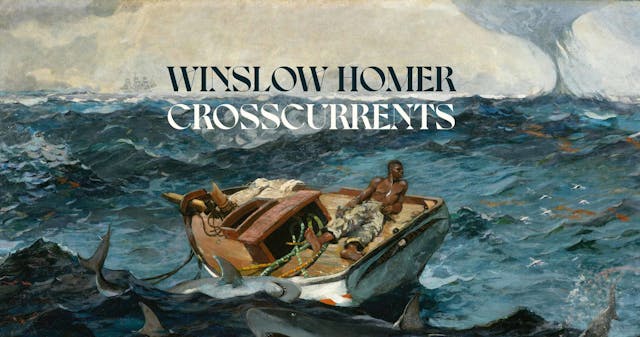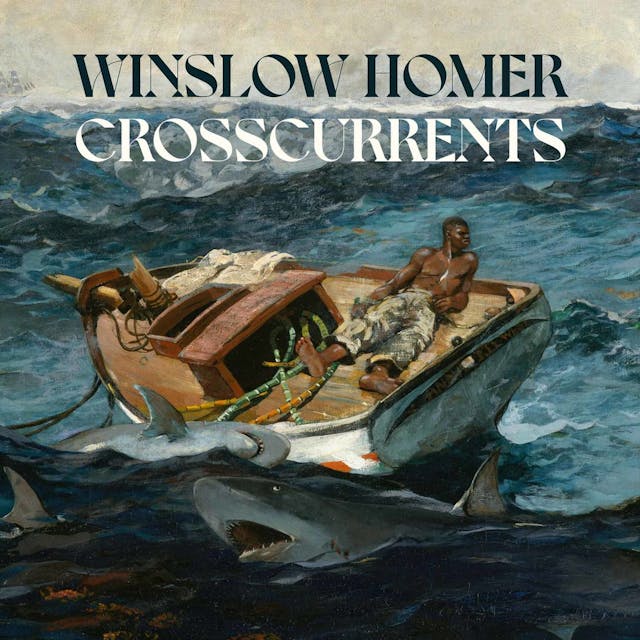

Winslow Homer: Crosscurrents
Contemporary Dialogues in The American Wing
On view through Fall 2022
Elizabeth Colomba, Armelle
Gallery 771

Armelle, a portrait of the artist’s cousin, was inspired by John Singer Sargent’s Madame X (1883–84). Armelle gazes toward a watercolor painted in the Bahamas by Winslow Homer, Under the Palm Tree (1885, National Gallery of Art). Throughout her art, Colomba centers stories of Black women, drawing on her extensive knowledge of art history and her academic training to subvert Western notions of beauty. As she explains: “I . . . start from a story that exists and remake it in a way that is appealing to me, dressing the subjects in a certain way and making it more about my roots, which are a mix of French and Caribbean.” This work is on view in Gallery 771 of The Met’s American Wing.
Artist’s Perspective
“The sitter is Armelle, my cousin. Virginie Amélie Avegno, known as Madame X after her portrait by Sargent, was born in Louisiana to White creoles, a term now applied to individuals of mixed-race heritage. Her father served as a major in the Confederate Army during the American Civil War.
“The parallel between Armelle and Madame X is caustic and ironic. Both are creoles: X descends from a colonialist family; Armelle from one that would have been in bondage. Bestowing the same pose on my model, I challenge stereotypes, reframing history to apply a different narrative for the character.”
– Elizabeth Colomba
Elizabeth Colomba (French, b. 1976). Armelle, 1997. Oil on canvas. 30 x 24 in. (76.2 x 61 cm). Private collection. © 2022 Elizabeth Colomba / Artists Rights Society (ARS), New York
Gulf Streams
Gallery 767

Winslow Homer’s epic The Gulf Stream, a centerpiece of The American Wing galleries for more than a decade, has captivated viewers for over a century. From April 11, 2022, to July 31, 2022, it can be seen in the exhibition Winslow Homer: Crosscurrents, a sweeping survey—inspired by the painting—that considers his work through an interpretive lens of conflict.
Numerous artists, particularly those of color, have grappled with the tensions and ambiguities of Homer’s striking depiction of a lone Black seaman on a distressed boat, threatened by sharks and a waterspout in the powerful Atlantic current. Conceived as a contemporary dialogue with Crosscurrents, a special presentation in Gallery 767 of The Met’s American Wing (where Homer’s The Gulf Stream is normally displayed) features works by three generations of Black artists—Kerry James Marshall, Kara Walker, and Hugh Hayden—that engage with aspects of Homer’s image in compelling ways.
Marshall, celebrated for his grand-scale history paintings that center Black life through what he calls a “Black aesthetic,” produced an ambitious reimagining of Homer’s iconic subject in 2003, represented here in studies that reveal his creative process. Hayden, familiar with Homer’s The Gulf Stream through the work of Marshall, in turn created his own powerful three-dimensional adaptation of the theme in 2019.
Winslow Homer (American, 1836–1910). The Gulf Stream, 1899. Oil on canvas, 28 1/8 x 49 1/8 in. (71.4 x 124.8 cm). The Metropolitan Museum of Art, New York, Catharine Lorillard Wolfe Collection, Wolfe Fund, 1906 (06.1234)
Kerry James Marshall, Study for Gulf Stream

Part of a career-long practice that reconceives historical works, Marshall’s Gulf Stream transforms Homer’s dramatic composition, with its uncertain outcome, into what has been termed an “allegory of liberation,” rejecting Black trauma for Black joy. In this monochromatic mixed-media study, Marshall lays in the key elements for the finished painting. While storm clouds skid across the horizon, the presence of gulls above and a pelican in the foreground signals safe harbor nearby. The inventive framing device of the nautical rope, netting, shells, buoys, and anchors—sparkling with glitter—further transforms the scene of affluent leisure into a celebration.

These refined studies for two of the four figures in Marshall’s completed Gulf Stream painting reveal the artist’s attention to detail in expressing aspects of Black style in dress, hair, and demeanor. The figures’ relaxed manner and mood as they recline on the sturdy yacht echo—if to a very different effect—the seeming indifference or resignation of Homer’s protagonist to his disastrous circumstances.


These fluid studies of the central motif in Marshall’s painting Gulf Stream—the preternaturally calm sea—suggest a close study of Homer, an artist famed for his sparkling Atlantic seascapes in watercolor. The appearance of a small boat on the horizon in one of Marshall’s works also evokes Homer’s later addition of a ship as a sign of potential rescue for the stranded Black seaman in the original 1899 composition. Marshall jettisoned the single vessel in the more complete study for his Gulf Stream, replacing it with a fleet of gleaming sailboats.
Kerry James Marshall (American, b. 1955), Study for Gulf Stream, 2003–2004. Graphite, watercolor, glitter on paper, 38 3/4 x 47 1/2 in. (98.4 x 120.7 cm). Collection Walker Art Center, Minneapolis; Butler Family Fund, 2005. © Kerry James Marshall. Courtesy the artist and Jack Shainman Gallery, New York
Kerry James Marshall (American, b. 1955). Untitled figure study for Gulf Stream (left), 2003. Ink, graphite on paper. 16 1/2 x 14 7/8 in. (41.9 x 37.8 cm). Collection Walker Art Center, Minneapolis, Gift of the artist and Jack Shainman Gallery, 2005. © Kerry James Marshall. Courtesy the artist and Jack Shainman Gallery, New York
Kerry James Marshall (American, b. 1955). Untitled figure study for Gulf Stream (right), 2003. Charcoal, graphite on paper. 25 5/8 x 20 3/8 in. (65.1 x 51.8 cm). Collection Walker Art Center, Minneapolis, Gift of the artist and Jack Shainman Gallery, 2005. © Kerry James Marshall. Courtesy the artist and Jack Shainman Gallery, New York
Kerry James Marshall (American, b. 1955). Untitled water study for Gulf Stream, 2003. Watercolor, graphite on paper. 15 1/8 x 22 1/4 in. (38.6 x 56.7 cm). Collection Walker Art Center, Minneapolis, Gift of the artist and Jack Shainman Gallery, 2005. © Kerry James Marshall. Courtesy the artist and Jack Shainman Gallery, New York
Kerry James Marshall (American, b. 1955). Untitled water study for Gulf Stream, 2003. Watercolor on paper. 15 x 22 1/4 in. (38.3 x 56.7 cm). Collection Walker Art Center, Minneapolis, Gift of the artist and Jack Shainman Gallery, 2005. © Kerry James Marshall. Courtesy the artist and Jack Shainman Gallery, New York
Hugh Hayden, Gulf Stream (skeleton study)

Brooklyn-based sculptor and architect Hugh Hayden came to know Homer’s The Gulf Stream through Kerry James Marshall’s empowering revision, what Hayden calls a “sort of a Fresh Prince of Bel-Air remix of art history.” Adapting the subject in three-dimensional anthropomorphic terms, the sculptor presents his sailing vessel with twelve ribs, evoking a Leviathan or sea serpent that references both the threat and salvation in Homer’s work. By rendering the skeletal hull “beached and shipwrecked,” Hayden imagines the Black protagonist “safely ashore in this new world . . . at least I hope.”
Hugh Hayden (American, b. 1983). Gulf Stream (skeleton study), 2019. Whitewashed plywood with steel bracket. 24 1/4 x 7 1/2 x 29 1/2 in. (61.6 x 19 x 74.9 cm). © Hugh Hayden, Courtesy Lisson Gallery
Crossings
Gallery 767

The title of Emanuel Leutze’s Washington Crossing the Delaware, on view in Gallery 760, is arguably better known than the artist himself. Evoking patriotic feelings in some viewers, conflict and struggle in others, this commanding icon—an unavoidable highlight of The Met’s American Wing—continues to spark debates about political ideas in the public square. In the nearly two centuries since Leutze painted the canvas, several artists, especially those of color, have responded to the contrived subject, from Black Americans Jacob Lawrence, Robert Colescott, and Kara Walker to Indigenous (Cree) Kent Monkman. Each of their provocative works confronts the biases of American history and mythmaking, while revealing the critical role art plays in shaping popular narratives.
Walker’s incendiary The Crossing (2017), in particular, interrogates notions of U.S. power and patriotism in ways that have become ever more relevant since the violent attack on the Capitol on January 6, 2021. Her monumental diptych offers an inventive response to two iconic paintings at The Met that address the realities of a precarious ship of state: the Leutze and Winslow Homer’s The Gulf Stream (1899, reworked by 1906). As such, The Crossing resonates with the reimaginings by Kerry James Marshall and Hugh Hayden as a contemporary dialogue with Winslow Homer: Crosscurrents.
Emanuel Leutze (American, 1816–1868). Washington Crossing the Delaware, 1851. Oil on canvas, 149 x 255 in. (378.5 x 647.7 cm). The Metropolitan Museum of Art, New York, Gift of John Stewart Kennedy, 1897 (97.34). On view in Gallery 760
Kara Walker, The Crossing

Walker is famous for her powerful artworks that challenge romanticized narratives of America’s past. On January 20, 2017, the day of the inauguration of Donald J. Trump as the 45th U.S. President, the artist began this monumental drawing. While referencing a number of iconic works, such as Homer’s (through the symbolic shark at right), it alludes primarily to Leutze’s Washington Crossing the Delaware. Reflecting the political chaos of the election and its aftermath, Walker depicts the paper-cap-wearing captain of an immobilized ship of state leading the country into iceberg-strewn disaster, while diverse figures struggle and seek escape. This is the first public display of The Crossing, a reproduction of which initially appeared in the New Yorker.
Kara Walker (American, b. 1969). The Crossing, 2017. Watercolor and graphite on paper, 89 x 144 in. (226.1 x 365.8 cm). © Kara Walker, courtesy of Sikkema Jenkins & Co. and Sprüth Magers